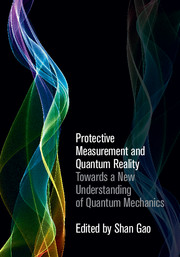Book contents
- Frontmatter
- Dedication
- Contents
- List of Contributors
- Preface
- Acknowledgements
- 1 Protective measurement: an introduction
- Part I Fundamentals and applications
- Part II Meanings and implications
- 7 Measurement and metaphysics
- 8 Protective measurement and the explanatory gambit
- 9 Realism and instrumentalism about the wave function: how should we choose?
- 10 Protective measurement and the PBR theorem
- 11 The roads not taken: empty waves, wave function collapse and protective measurement in quantum theory
- 12 Implications of protective measurement on de Broglie–Bohm trajectories
- 13 Entanglement, scaling, and the meaning of the wave function in protective measurement
- 14 Protective measurement and the nature of the wave function within the primitive ontology approach
- 15 Reality and meaning of the wave function
- Index
- References
7 - Measurement and metaphysics
from Part II - Meanings and implications
Published online by Cambridge University Press: 05 January 2015
- Frontmatter
- Dedication
- Contents
- List of Contributors
- Preface
- Acknowledgements
- 1 Protective measurement: an introduction
- Part I Fundamentals and applications
- Part II Meanings and implications
- 7 Measurement and metaphysics
- 8 Protective measurement and the explanatory gambit
- 9 Realism and instrumentalism about the wave function: how should we choose?
- 10 Protective measurement and the PBR theorem
- 11 The roads not taken: empty waves, wave function collapse and protective measurement in quantum theory
- 12 Implications of protective measurement on de Broglie–Bohm trajectories
- 13 Entanglement, scaling, and the meaning of the wave function in protective measurement
- 14 Protective measurement and the nature of the wave function within the primitive ontology approach
- 15 Reality and meaning of the wave function
- Index
- References
Summary
Introduction
It is a prima facie reasonable assumption that if a physical quantity is measurable, then it corresponds to a genuine physical property of the measured system. You can measure a person's mass because human beings have such a property. You can measure the average mass of a group of people because groups of people have such a collective property. And so on.
Now it would be truly surprising – miraculous, perhaps – if you could determine the average mass of a group of people by making measurements on just one of them. To ascribe such a statistical property to an individual looks like a category mistake. At first glance, protective measurements seem to pull off just such a miracle, determining, for example, the expectation value of position for an ensemble of particles via a measurement performed on one of them. The lesson we are supposed to draw, of course, is that expectation values are not statistical properties at all, despite their name. Rather than being an average over an ensemble of systems, the expectation value of position for a particle is a physical property of the individual system, and the wave function, as the bearer of these properties, is a physical entity (Aharonov, Anandan and Vaidman, 1993).
The protective measurement procedure has been challenged (Uffink, 1999; Gao, 2013; Uffink, 2013), but for present purposes I will assume that protective measurements exist, at least in principle, that are capable of revealing “statistical” properties like expectation values in a single measurement. My aim here is not to challenge the existence of such a physical procedure, but rather to explore the arguments that connect the existence of protective measurements with conclusions concerning the nature of physical reality. What protective measurements are sup- posed to show is that “epistemological” interpretations of the quantum state are untenable – that the wave function of a system must instead be interpreted “onto- logically” (Aharonov, Anandan and Vaidman, 1993: 4617).
- Type
- Chapter
- Information
- Protective Measurement and Quantum RealityTowards a New Understanding of Quantum Mechanics, pp. 93 - 106Publisher: Cambridge University PressPrint publication year: 2015



